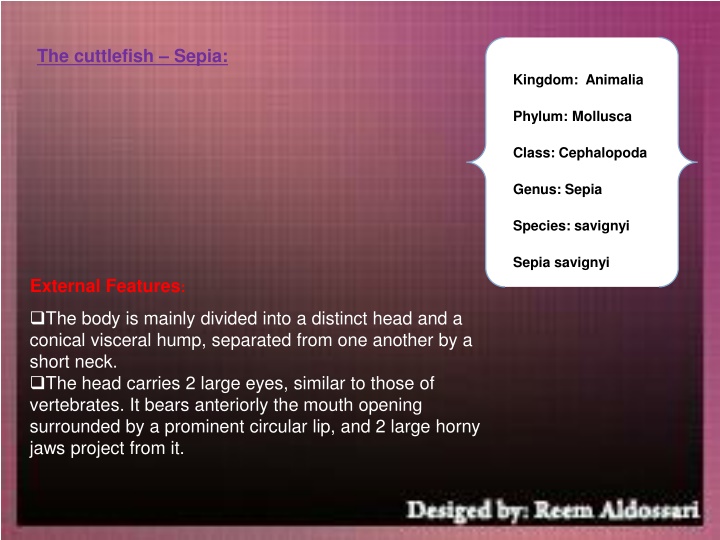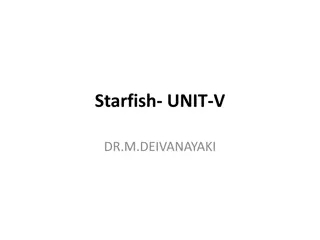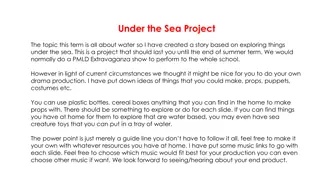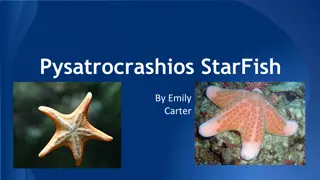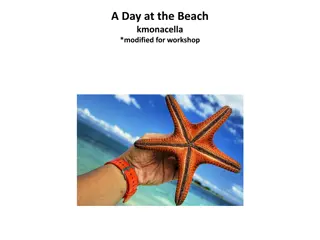The Amazing Cuttlefish and Starfish
The cuttlefish, Sepia savignyi, features distinct external characteristics such as a conical visceral hump, eyes, arms with suckers, and tentacles used for capturing prey. On the other hand, the starfish, Astropecten relitaris, showcases a star-shaped body with tube feet for locomotion, pedicellariae for cleaning, and ambulacral grooves for movement. Both these fascinating marine creatures exhibit unique adaptations for survival.
Download Presentation

Please find below an Image/Link to download the presentation.
The content on the website is provided AS IS for your information and personal use only. It may not be sold, licensed, or shared on other websites without obtaining consent from the author.If you encounter any issues during the download, it is possible that the publisher has removed the file from their server.
You are allowed to download the files provided on this website for personal or commercial use, subject to the condition that they are used lawfully. All files are the property of their respective owners.
The content on the website is provided AS IS for your information and personal use only. It may not be sold, licensed, or shared on other websites without obtaining consent from the author.
E N D
Presentation Transcript
The cuttlefish Sepia: Kingdom: Animalia Phylum: Mollusca Class: Cephalopoda Genus: Sepia Species: savignyi Sepia savignyi External Features: The body is mainly divided into a distinct head and a conical visceral hump, separated from one another by a short neck. The head carries 2 large eyes, similar to those of vertebrates. It bears anteriorly the mouth opening surrounded by a prominent circular lip, and 2 large horny jaws project from it.
Eight pointed arms,each provided with 4 rows of suckers on its inner surface, and 2 much longer tentacles, carrying suckers only at their expanded tips, arise at the anterior end of the head, around the mouth opening (the tentacles are used in catching the prey and the arms for holding it while it is being devoured). The arms and tentacles probably represent the highly modified anterior part of the foot, and hence the name Cephalopoda. The posterior part of the foot is modified to form the large muscular funnel which you see on the ventral side of the head (through which water is forced out of the mantle cavity, causing the animal to jerk quickly backwards
The Starfish Kingdom: Animalia Phylum: Echinodermata Class: Asteroidea Genus: Astropecten External Features: Species: relitaris Astropecten relitaris The body is star-shaped consisting of a central disc prolonged radially into 5 felxible triangular arms with tapering tips. The body is markedly flattened, with two distinct surfaces, a lower oral surface and an upper aboral surface. On the oral surface, note the mouth opening in the centre, surrounded by-a soft membranous area, the peristome. Five broadly open ambulacra grooves extend out from the mouth and pass each along the entire length of one of the arms. (See star).
Note that a series of long conical structures known as the tube feet project in 2 rows along each ambulacral groove (organs of locomotion which-are capable of great extension and contraction during life). The terminal tube foot or tentacle, which stands at the tip of each arm, has a pigmented spot, the eye, at its base (light sensitive). Note that very small modified spines, known as pedicellariae, project around the spines (serve to clean the body surface and ambulacral grooves from detritus and foreign objects). Each has 2 distal ossicles working opposite each other like pincer blades,and a 3rd basal ossicle as a stalk.
Thank you for your attention
